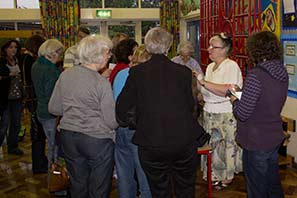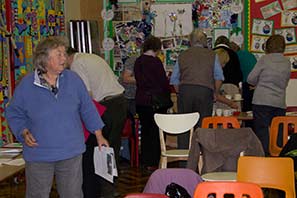Harlow Carr (9-7-12)

By gum – it was cold up North!
Do you know, I'd actually forgotten how bitter the wind could be when it whips across the lawns at Harlow Carr? Even though it was July 1st it actually felt more like mid-April. But it's such a wonderful location that within five minutes of stepping off the coach you can stand at the top of the terrace and see everything spread out before you – including that sheltered little haven otherwise known as Betty's Tea House.
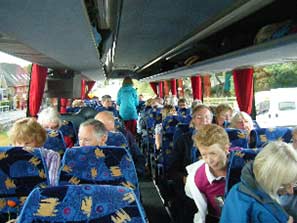 It was good to be back and comforting to see that the professionals are battling the elements of summer 2012 just as we are. The fabulous main borders looked a bit battered and less glorious than you would have expected and quite a few of the beds were empty – not sure if the contents had been washed away by the recent floods or whether the plantsmen had delayed planting until the weather warmed up a bit.
It was good to be back and comforting to see that the professionals are battling the elements of summer 2012 just as we are. The fabulous main borders looked a bit battered and less glorious than you would have expected and quite a few of the beds were empty – not sure if the contents had been washed away by the recent floods or whether the plantsmen had delayed planting until the weather warmed up a bit.
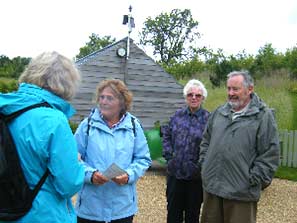 There were some changes this year: the Queen Mother's Lake is undergoing redevelopment, the Library Building is complete and now sports a magnificent 'living' roof. The huge chrome spade is still in situ but I don't remember seeing the wicker boxing hares before. There is a beautiful new stone bridge across the stream and that was one area that was in the peak of perfection. The banks of Harlow Carr candelabra primula along the stream side were so gorgeous they would make Liberace blush. Lots of primula vialii spiked up the colour and the gunnera was obviously in overdrive.
There were some changes this year: the Queen Mother's Lake is undergoing redevelopment, the Library Building is complete and now sports a magnificent 'living' roof. The huge chrome spade is still in situ but I don't remember seeing the wicker boxing hares before. There is a beautiful new stone bridge across the stream and that was one area that was in the peak of perfection. The banks of Harlow Carr candelabra primula along the stream side were so gorgeous they would make Liberace blush. Lots of primula vialii spiked up the colour and the gunnera was obviously in overdrive.
 There's also a lovely little trial meadow sown with an annual seed mix containing poppies, flaxes, Bishops flower, tickseed, corn marigold, black eyed Susan and larkspur. Even on a cold afternoon the patch was humming with bees and insects.
There's also a lovely little trial meadow sown with an annual seed mix containing poppies, flaxes, Bishops flower, tickseed, corn marigold, black eyed Susan and larkspur. Even on a cold afternoon the patch was humming with bees and insects.
One thing I saw and would love to have a go at was an arching living screen made with salix viminalis which edged one of the gardens through time.
The Alpine House was looking really good with lots more specimens than at our last visit – it also provided a welcome shelter from the wind.
Then, of course, there was lunch at Betty's – what more could you want for a grand day out.
Margaret Paul
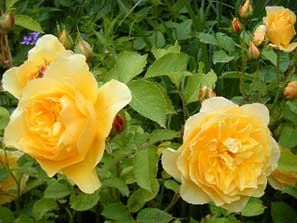
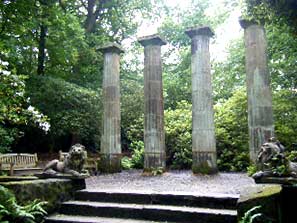
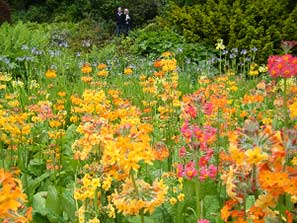

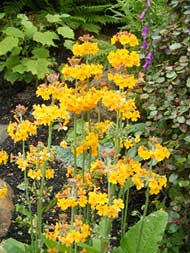
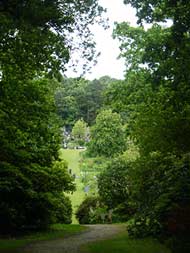
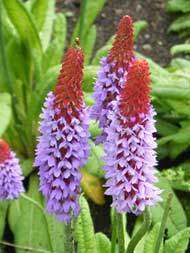



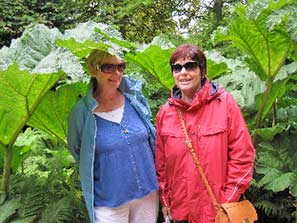
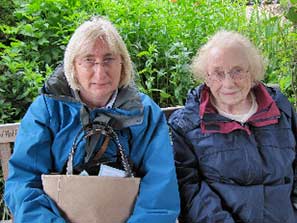
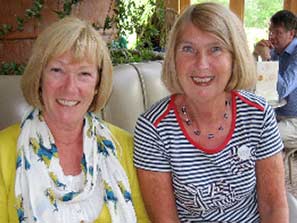

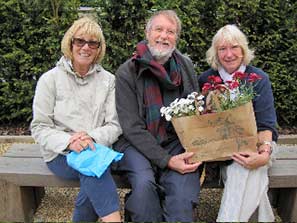
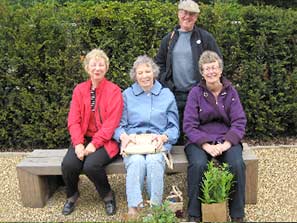


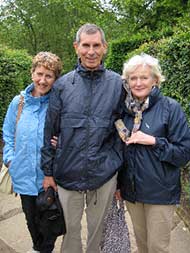
Photos by Mel Stanley & Judy Thomas
Ridgwold Farm Wymswold (27-6-12)

Ridgwold Farm Wymswold Wednesday 20th June.
What a lovely evening spent with Roger and Ann at Ridgwold Farm Wymswold. That yellow thing we sometimes see in the sky actually shone for us to make the evening even more enjoyable.
This is a 2½-acre outstanding garden around a new farmhouse set in rural landscape. Approached by a sweeping drive through an arboretum. Special interests including clematis pergola, wisteria, cytisus battandiere, spring-flowering shrubs, ivy cloister, rose garden, herbaceous borders, water feature with a large natural fish pond, kitchen garden, fruit and native plantation with woodland walks. All achieved during last 10years
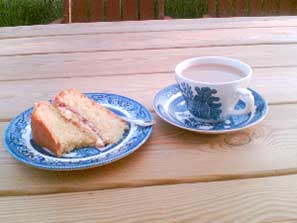 Thirty-two of our members attended and were given a conducted tour of this lovely garden which was packed with a great variety of beautiful and unusual plants. There was also a woodland walk which ended in a wide avenue of newly planted trees where you could look across their fields (full of young cows) to the church beyond all of which Ann could see from her kitchen window.
Thirty-two of our members attended and were given a conducted tour of this lovely garden which was packed with a great variety of beautiful and unusual plants. There was also a woodland walk which ended in a wide avenue of newly planted trees where you could look across their fields (full of young cows) to the church beyond all of which Ann could see from her kitchen window.
After all this we were given delicious home -made cakes and tea or coffee. A beautiful end to a perfect evening. Roger and Ann donated our entry fees of £111 to Macmillan Nurses .
Sue Ward
(Photos by Elaine Robinson)
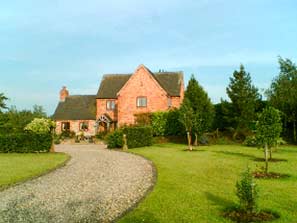



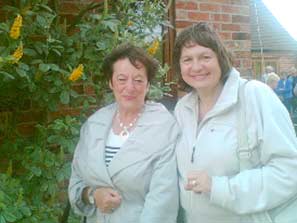
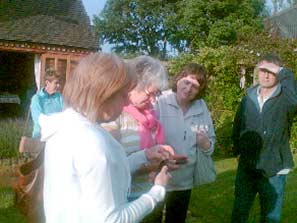

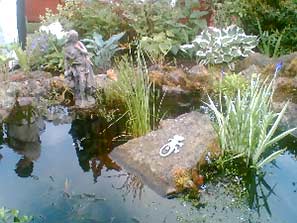

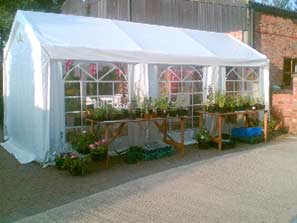
Pine House (12-6-12)
 The approach to Pine House didn't quite prepare us for
the treat that was in store on this cool May evening.
The approach to Pine House didn't quite prepare us for
the treat that was in store on this cool May evening.
Up the gravel drive bordered on one side by a hedge shaped as a massive red-eyed dragon and on the other side a beautiful old brick wall was adorned by Christmas-tree shaped cotoneasters. We came into a courtyard and were greeted by Sue Milward, the owner, who explained that the family had been in residence for 32 years.
When they had arrived, the garden comprised of lawns, shrubs and three massive Watsonia trees – only one of which survives. Since then Sue has created a garden of rooms in about 2 acres. There is a shady woodland walk through a water garden. To the front of the house is a broad, flagged terrace leading to a croquet lawn and a grass tennis court. To the east, a shrubbery leads you round to the topiary garden where Sue has sculpted box balls, pyramids and spirals.
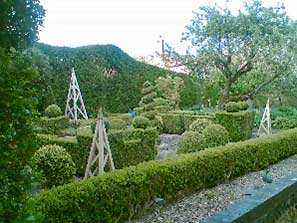 Further on is the potager garden: four
beds contained by Victorian brick edging and sporting large wooden obelisks all stuffed with
vegetables, salads and herbs and just a few steps from the kitchen door. A row of pleached lime
trees form a bold screen and in front is the pot garden where Sue displays her lavishly planted
containers and barrels.
Further on is the potager garden: four
beds contained by Victorian brick edging and sporting large wooden obelisks all stuffed with
vegetables, salads and herbs and just a few steps from the kitchen door. A row of pleached lime
trees form a bold screen and in front is the pot garden where Sue displays her lavishly planted
containers and barrels.
Pine House is not a large garden but the way it has been designed makes it feel much bigger. There are delightful little nooks and crannies – even an auricular theatre inside a pretty clematis-clad bower. There is a Victorian vinery, at present containing all the tender succulents soon to be moved to the courtyard. And then there is the Wisteria arch, still in tight bud when we visited but you can imagine how stunning it will be in full flower.
Our thanks to Sue and Deb for arranging this interesting visit.
Margaret Paul
 Here's our programme for the rest of the summer:
Here's our programme for the rest of the summer:
Wednesday 20th June Ringwold Farm, Wymswold. Evening visit leaving at 6.20pm. Cost will be £3.50 for the visit.
Sunday, 1st July, RHS Gardens, Harlow Carr, Harrogate. Our annual RHS visit by coach leaves Cropwell Bishop at 9.00am. Cost will be £15 for members and £17 non-members.
Thursday 2nd August Crows Nest Cottage, Oxton. Evening visit leaving at 6.20pm. Cost will be £5.00 for two gardens and includes refreshments.
Sunday, 16th September, Trentham Gardens, Stoke-on-Trent. Coach leaves Cropwell Bishop at 9.00am. Cost will be £20 for members and £22 non-members.
Full details of these visits will be shown in the newsletter closer to the time.
Contact Sue Ward at "su2su22@yahoo.co.uk" or on 0115 989 3516 if you are interested.
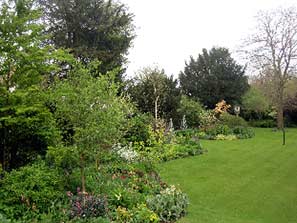

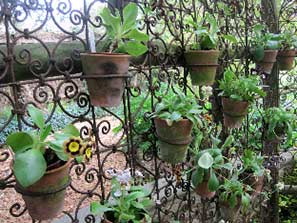
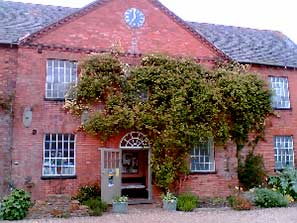
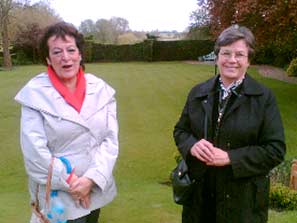
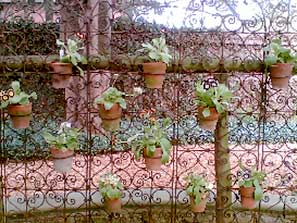





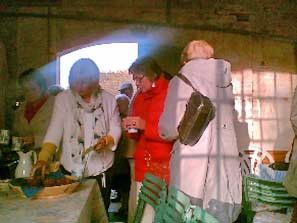

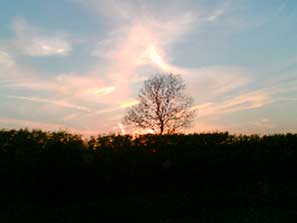


To be a Bee or not a Bee? Not likely! (22-5-12)
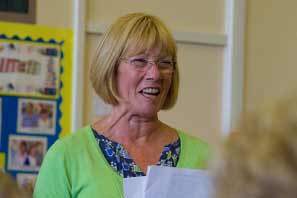 Do you know what is going in on inside a beehive? Honey, wax and lots of buzzing for sure, but what about the little ones who create it all and how do they organise themselves?
Do you know what is going in on inside a beehive? Honey, wax and lots of buzzing for sure, but what about the little ones who create it all and how do they organise themselves?
Only someone with a deep knowledge of such things is in a position to tell us, and it would need someone with wit and enthusiasm to tell the full story without the use of visual aids.
The 50+ members of the Gardening Club who heard Sandra Hart present her talk, 'The City of Bees", at the Primary School last night, soon realised they were in safe hands.
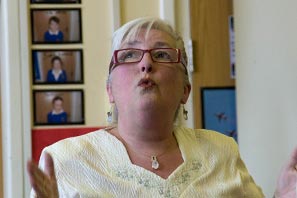 A computer and projector are unnecessary: a wonderful picture can be painted using words and gestures—and Sandra proved a very able artist.
A computer and projector are unnecessary: a wonderful picture can be painted using words and gestures—and Sandra proved a very able artist.
You may have come to believe that government and politics is a cold, heartless and nasty business, but compared with the goings-on inside a beehive, our politicians are the equivalent of Andy Pandy!
The Queen Bee has one job to do: lay tens of thousands of eggs. The real power lies with the many thousands of other bees in the hive—all female.
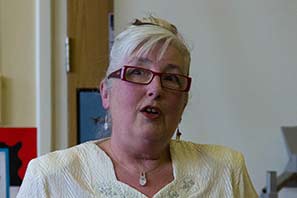 There are some male bees tucked away somewhere below but they can be considered useless—except when the Queen Bee needs fertilising. Once those few males have done their 'job', they meet a very grisly ending that is too awful to describe here!
There are some male bees tucked away somewhere below but they can be considered useless—except when the Queen Bee needs fertilising. Once those few males have done their 'job', they meet a very grisly ending that is too awful to describe here!
Even the birth of a new Queen Bee is a terrifying affair. Some 16 baby-bee princesses hatch deep inside the hive: bees can choose the sex of their offspring and, clearly, don't waste time having princes. These babies are assessed by the colony's population. Those who don't seem up to the job are killed off. The 'best princess' is allowed to live and her first function is to kill off the remaining princesses. And you thought humans were ruthless!
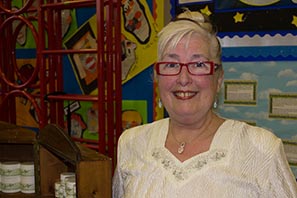 It takes around a month for a worker bee to grow up and complete an apprenticeship in the organisation and running of the hive. They quickly graduate and are soon carrying out their ultimate job of collecting pollen and nectar. In so doing, they inadvertently pollenate plants and so keep planet earth functioning and, ultimately, enable humans to survive.
It takes around a month for a worker bee to grow up and complete an apprenticeship in the organisation and running of the hive. They quickly graduate and are soon carrying out their ultimate job of collecting pollen and nectar. In so doing, they inadvertently pollenate plants and so keep planet earth functioning and, ultimately, enable humans to survive.
Evidence that bee populations around the world have suffered huge declines in recent years is alarming, to say the least. Scientists are finding reasons for the decline but it will need some decisive action by those in power (humans) to eliminate the causes of the problems.
Amazing what you learn in an evening down at the Village School.
Tony Jarrow
